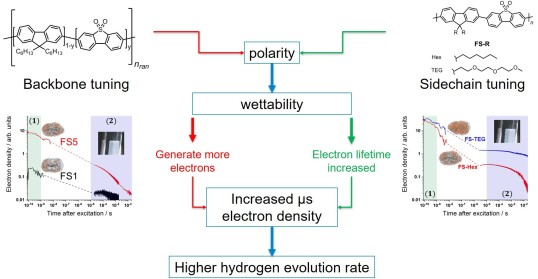Summary
I'm a Research Associate at the Centre for Doctoral Training in Processable Electronics, working with Professor James Durrant in the Department of Chemistry. I use spectroscopy to investigate structure-function-performance relationships in organic photocatalysts for the formation of solar fuels - focusing on the oxidation of water and other organic solvents using carbon nitrides.
I did my PhD at Imperial College (2017-2022) under the supervision of Professors Jenny Nelson (Physics) and James Durrant, studying linear conjugated polymers for hydrogen evolution from water. I've presented my research all around the world, and was recently selected to represent the Physics department at the 2020 Faculty of Natural Sciences Research Showcase. For a 12-minute overview of my work, you can find my talk here:
imperial.ac.uk/natural-sciences/research/showcases-seminars/2020/
I am also an Associate Fellow of the Higher Education Academy.
My research
High performance, light absorbing semiconductor materials are of intense interest for use in photocatalytic and photoelectrochemical devices for the solar-driven generation of hydrogen from water.
I am currently studying the photophysics of carbon nitrides for water oxidation, as a part of the Methasol project (https://methasol.eu/)
In my PhD, I studied a series of novel linear conjugated polymer photocatalysts by varying the chemical structure of both the polymer side-chains and the polymer backbone. We use computational, spectroscopic, electrochemical and structural characterisation techniques to understand the different photocatalytic activities of these systems.
We found that the inclusion of polar groups into the polymers improves photocatalytic performance by allowing a higher density of photogenerated electron polarons to accumulate. However, polar backbone and side-chain modifications improve this electron density in different ways. In a field in which mechanistic understanding has not kept pace with the development of new materials, this work offers insight into potential design rules for future organic photocatalysts.

Figure: A cheat sheet for improving photocatalysts: a summary from my talk at the Imperial College Faculty of Natural Sciences Symposium 2020
Publications
Journals
Hillman SAJ, Sprick RS, Pearce D, et al., 2022, Why do sulfone-containing polymer photocatalysts work so well for sacrificial hydrogen evolution from water?, Journal of the American Chemical Society, Vol:144, ISSN:0002-7863, Pages:19382-19395
Pulignani C, Mesa C, Hillman S, et al., 2022, Rational design of carbon nitride photoelectrodes with high activity toward organic oxidations, Angewandte Chemie International Edition, ISSN:1433-7851
Bozal-Ginesta C, Rao RR, Mesa CA, et al., 2021, Redox-state kinetics in water-oxidation IrOx electrocatalysts measured by operando spectroelectrochemistry, Acs Catalysis, Vol:11, ISSN:2155-5435, Pages:15013-15025
Cong S, Creamer A, Fei Z, et al., 2020, Tunable control of the hydrophilicity and wettability of conjugated polymers by a postpolymerization modification approach., Macromolecular Bioscience, Vol:20, ISSN:1616-5187, Pages:1-8
Woods DJ, Hillman S, Pearce D, et al., 2020, Side-chain tuning in conjugated polymer photocatalysts for improved hydrogen production from water, Energy & Environmental Science, Vol:13, ISSN:1754-5692, Pages:1843-1855

